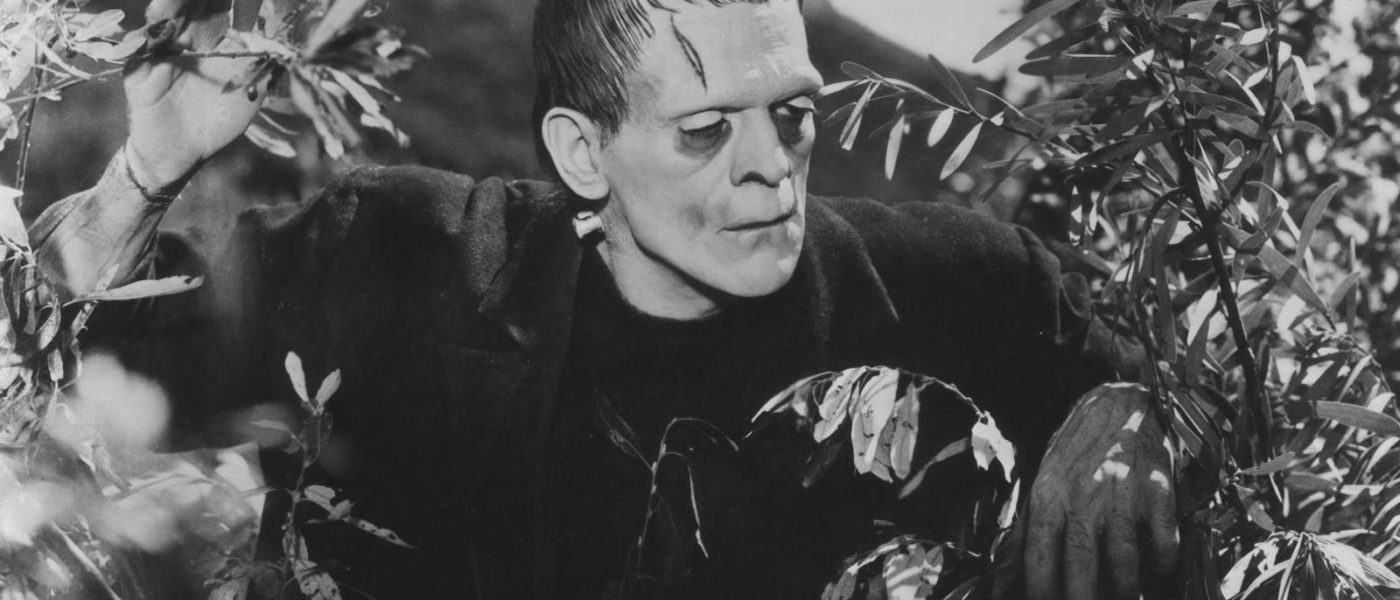A Slightly Obsessed Halloween Special!
Yet another Halloween season is fast upon us, the rotting trees, mournful processions, and hangman’s posts infusing the darkling-blasted, cycloramic plain with fell intent. Creeping stealthily through boneyards and charnel houses with one’s hunchbacked assistant, one digs ever deeper into the silty loam to add to the pile of nightmare upon nightmares, a groaning and creaking assemblage of tissue, sinews, organs, and… horror movies?
Yes, your somewhat misshapen, mildly warped, and Slightly Obsessed correspondent has once again undergone his October annual ritual of the Halloween Movie Marathon. This year, it is, of course, the Frankenstein Monster that haunts the waking, daylight dreams of your humble horror fan. Unleashed by Universal Pictures on November 21st, 1931, this image, spirit, and creation of modern horror found its first movie audiences wholly unprepared for the shambling, apocalyptic, strangely expressive vision of dread symbolized, in its initial title card reference, by the darkest and most inscrutable punctuation mark of the English language: “?”!
Over the course of 85 years and 12 movies, film history has grappled with the meaning and import of that provocatively-placed question mark as it has, in its various iterations, inspired blood-curdling fear and bone-chilling dread – while also inviting sympathy, affection, and even parody – across countless sequels and subsequent spiritual cinematic heirs alike. From The Frankenstein Creature’s 1931 debut, and through 3 sequels, 3 monster mash-ups, 3 parodies, and 2 “legacy” appearances, arguably the Universal version of Mary Shelley’s immortal 1818 classic has proved the most enduring image of Promethean terrors and scientific overreach gone disastrously awry – while also, as in the original classic, suggesting the undeniably human qualities behind its monstrously outsized and revoltingly stitched-together exterior.
Join us, then, as we trace the strange and uncanny, the odd and touching, the voiceless yet eloquent movie monster across every one of his flat-headed, neck-bolted, scar-ridden; heavy-booted, slouching, stumbling, and growling screen appearances!
Frankenstein
(1931, dir. James Whale)
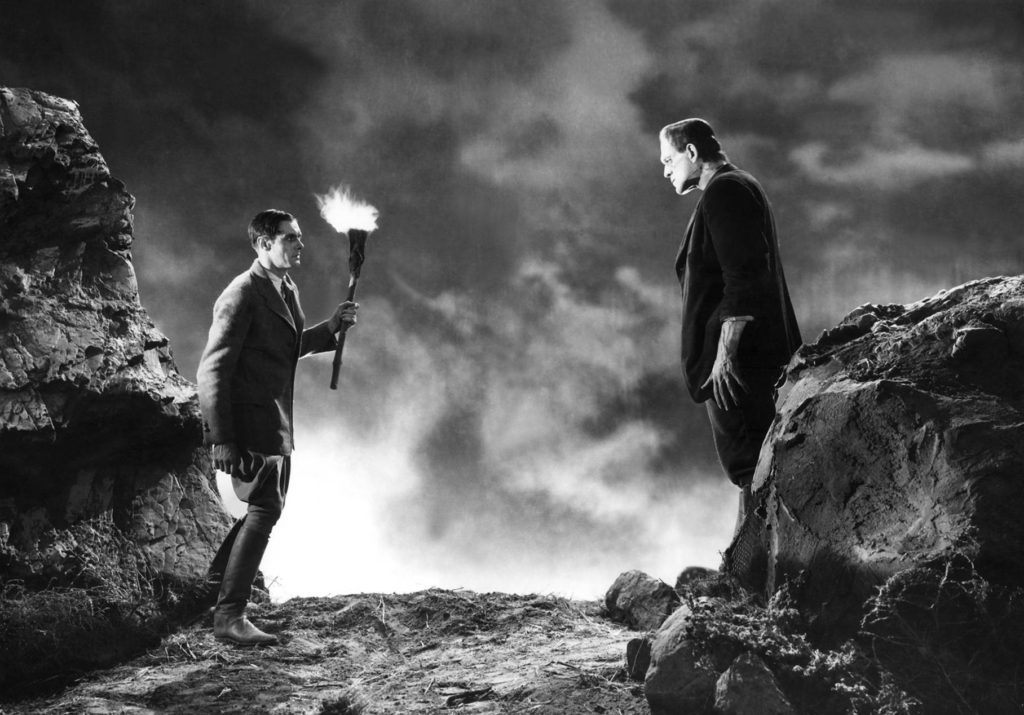
The successive series of off-axial edits that famously introduce The Monster may not have been the first time a Hollywood feature had employed the space and dimension-shattering technique of the “jump cut”, but the shock and pure visceral impact of that memorable screen entrance announces the most terrifying creature of literature, stage, and (now) film with the cinematic force of a blunt object wielded against the audience’s collective vision. Pushing us, the unwilling spectator, ever nearer to a tight close-up on the heavy brow, sunken cheeks, dark-lidded eyes, and dull, as yet uncomprehending, thousand-yard stare of Frankenstein’s recent creation, these jagged images punctuate the good doctor’s histrionic cries, still resounding from the previous lightning-searing, gizmo-crackling scene, in the way a faltering hand twitch from beneath a surgical shroud could not. Yes, IT’S now truly ALIVE.
Much has been said about how far the film’s vision of Frankenstein’s Monster veers from its original conception – particularly, its transformation from the agile, eloquent creature of the page to the staggering, wordless monster of the screen – but essentially the changes serve to foreground the equally essential relationship between Creator and Created. Frankenstein and his Monster are silently mirrored from their very first scene through direction, lighting, framing, makeup, and performance; naturally lumbering toward the alarmed scientist, who in turn naturally shrinks backward with the shudder of not only revulsion, but recognition. Foregoing the mutually philosophical exchanges between the pair in the novel, the purely visual configuration of the inextricably-linked characters – one expressive, the other mute – continues through each shared scene, and indeed informs every scene they do not share to the point of psychic linkage. (How else, for instance, would the Monster know when to enter the bridal chamber of Frankenstein’s fiancee from an outside window at the precise moment Frankenstein has himself locked its front entrance?)
So as the pair circle each other around the revolving wheel inside the burning windmill, the film’s climactic death struggle (which should have properly ended with both characters’ deaths) powerfully reinforces the screen dynamic between the overreaching scientist and his unnatural creation; implicit visually, again, as their faces merge through the smoke and gears in tightening close-ups. From Frankenstein-the-man’s ecstatic cries as he transcended the boundaries of life and science to Frankenstein-the-monster’s anguished howls as he flees a world he did not ask to be brought into, we identify with both as one reaches through the roof of his watchtower toward the stars and, soon after, as the other grasps longingly at light beams glittering through that same vertical opening.
FRANKENSTEIN is, finally, one and the same; and the stylistic, dramatic, and thematic technique of this greatest of all Frankenstein adaptations invites a closer audience identification than we might readily care to admit. The hallmark of true horror!
Bride of Frankenstein
(1935, dir. James Whale)
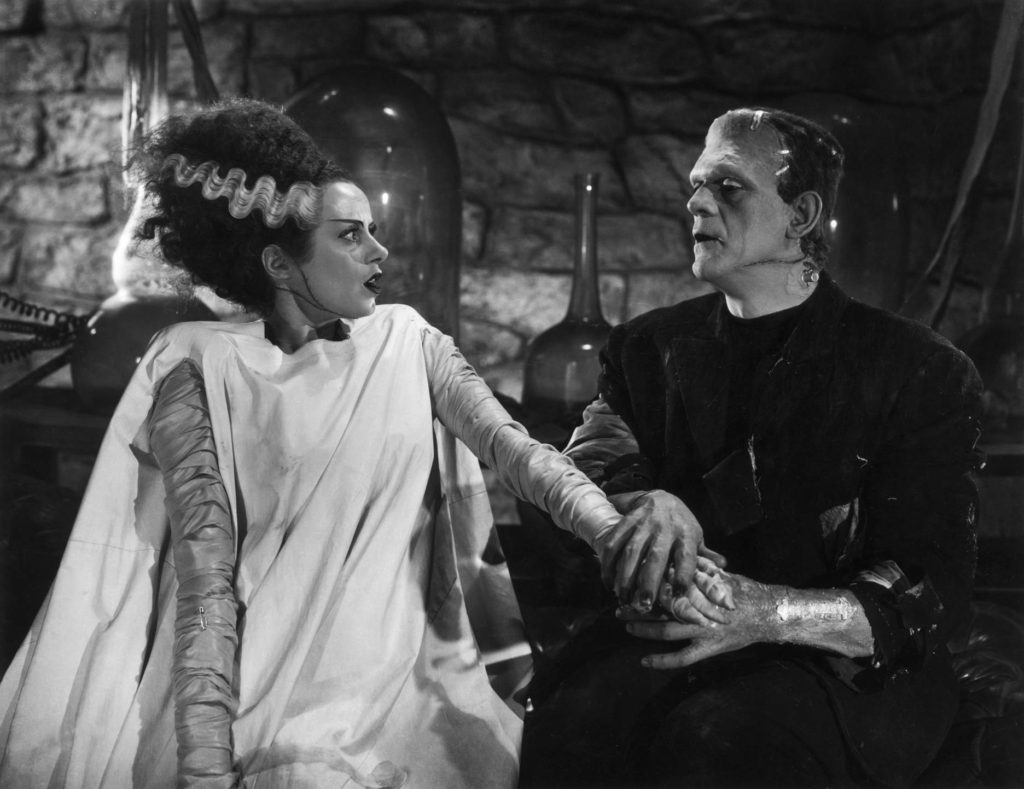
As undoubtedly the most “layered” of all horror/science fiction/comedies (and how many of those have been made?), Frankenstein‘s direct sequel is, in the estimation of many, actually superior to the original. In addition to the technical, atmospheric, and dramatic improvements made in terms of set design, photography, and screenplay, the musical motifs announcing the entrance and recurrence of each major Bride of Frankenstein character (another innovation on the original) successively expand the thematic scope of merged man-and-monster into no less than four main protagonists.
As in the original 1931 film, the change from the novel’s “Victor” to “Henry” Frankenstein makes the first name less exotic, while also less thematically resonant, though the essentially good-if-wearied doctor is nonetheless still haunted here by his sins of the past, sidelined both physically and mentally by the reemergence of his monstrous self-image. Spurred from inaction to (initially) reluctant action by intentionally punning “grave matters”, the character appears weakened, enervated, more acted upon than acting, and his manipulation at the hands of others shows one who has become as unfortunate a figure of walking death as his creation.
The engine of both the plot and unique tone of the film, literally sparking each increasingly bizarre plot development with an undying arsenal of gallows humor and black magic, is thus left to and is unerringly supplied by the one and (one can hope) only Dr. Septimus Pretorius. A shock of wavy white hair over a gaunt and disdainful, perpetually scowling and sniffing, cadaverous-like face, this macabre and mocking figure of death, unambiguously so for all the not-so-good doctor’s many ambiguities, drives forth every delicious layer of the film to the point where viewers may not know whether they are watching a horror film or a comedy.
Which brings us, penultimately, to the one figure who is neither a source of comedy nor horror in Bride of Frankenstein, the Monster himself. The major “development”, as related by Dr. Pretorius, is his recently-discovered gift of speech, and the halting, guttural, newly-found expressiveness of the creature adds a layer of complexity to his sufferings and torments. Fuller in face and seemingly larger in figure than in his previous screen adventure, with only a few burn marks to account for his fiery fate in the original, Frankenstein (for, as the title seems to imply, hasn’t he earned the name of his creator by this point?) is, counter-intuitive to his even more frightening appearance, the film’s true heart.
With the rawhr!-like staccato theme announcing each entrance of the monster, and a mincing and whirling waltz each appearance of Pretorius, the grandest musical vista, however, is reserved for the title character, whose arrival at the film’s climax tops the creation scene of the original film both in terms of sheer filmmaking technique and the tom-tom beat of timpani that so effectively punctuates it. From the film’s prologue, Lord Byron’s disbelief that “that lovely brow conceived of Frankenstein” finds its ultimate payoff when the balance-tottering, Egyptian goddess-like, lightning bolt-coiffured Bride, in no less of a jolting jump cut that first introduced the monster himself, is revealed to be… none other than the author herself.
With its multiple layers of wit, irony, sentimentality, dark humor, tragedy, and sublime characterization, Bride of Frankenstein proves one of Classic Hollywood’s most enduring films, and possibly its greatest, most distinctive creation.
Son of Frankenstein
(1939, dir. Rowland V. Lee)
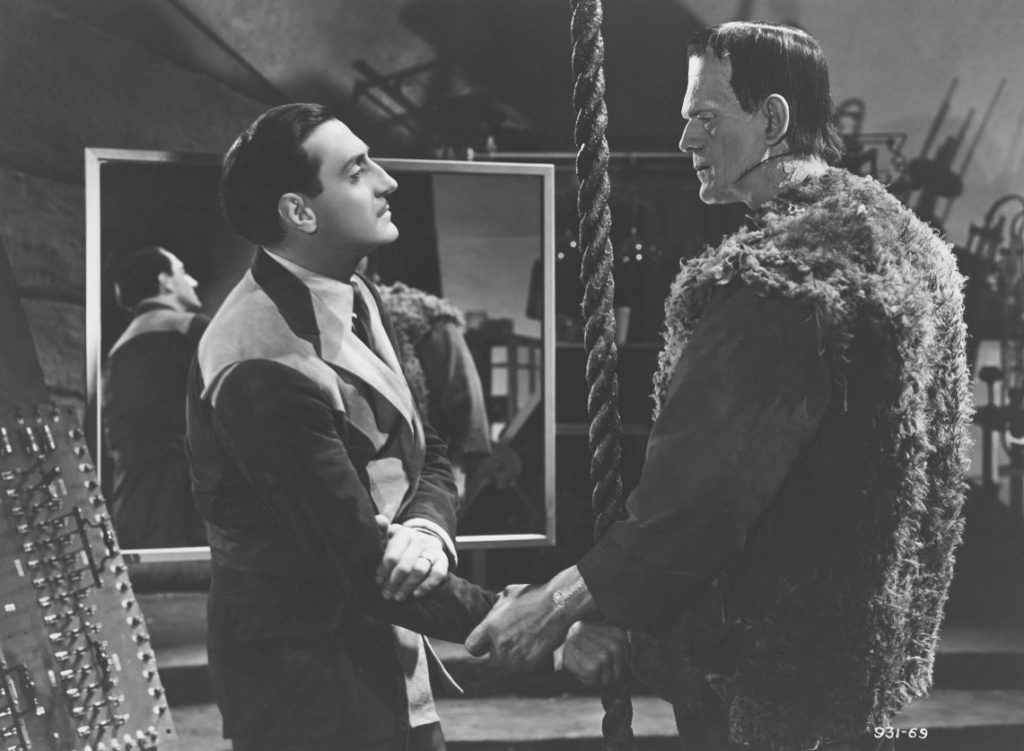
“Slick”, as opposed to “layered”, is how one might best describe the second sequel to Frankenstein, the Son of whom finds his late father’s transgressions dominating Wolf von Frankenstein’s own overreaching ambitions. Made in that movie-fateful year of 1939, which also saw The Wizard of Oz and Gone With the Wind among countless others, the classical style of filmmaking reaches its zenith with even an unnecessary sequel in terms of pure entertainment.
With its streamlined, Art Deco-like interiors dulling the Gothic atmosphere of the first two films, so too is the Monster reduced further by having survived death (twice) and by being here marginalized as mere bodily appendage (literally) to the monstrous machinations of others. Bereft once more of the power of speech, and his still lumbering form now draped in a heavy sheepskin coat, Son of Frankenstein finds the once pitiable, now manipulated creature caught between the murderous, revenge-driven motives of his “friend” and protector – the hunchbacked, broken-necked, lute-playing peasant outlaw Ygor – and the son of his creator’s inescapable desire to claim his birthright by “improving” his father’s creation.
The dedicated, one-armed local policeman Inspector Krogh, who acts as foil, friend, and pursuant to young Wolf, is a great addition (and their much-mocked game of darts towards the film’s climax is in the eyes of this viewer quite fun), but even he is reduced to a bodily appendage when the Monster once again tears off his limb… though this time it’s an artificial one. Throw in a dangerous mob’s worth of torch-wielding, rampaging villagers, a cavernous underground laboratory full of hidden doors and secret passages, and a bubbling sulphur pit to swallow up the whole proceedings: one can’t help but see that Universal clearly got what they paid for in terms of pure screen spectacle, yet this mammoth production somehow fails to register the emotional complexity of its predecessors.
The moment that registers an emotional core on an equal footing with the first two films, however, is counter-intuitively (or perhaps intuitively) a quieter one. The first encounter between the “awakened” Monster and the son of his creator is played entirely in silence, with the two figures carefully studying each others’ features and regarding each other in reaction through the reflection of a mirror. Though, as a title, Brother of Frankenstein would make just about as much sense as Bride of Frankenstein as far as who precisely the name “Frankenstein” refers to, it does seem appropriate – dramatically, thematically, and sequel sequentially – that both characters should essentially share the same “father”.
The Ghost of Frankenstein
(1942, dir. Erle C. Kenton)
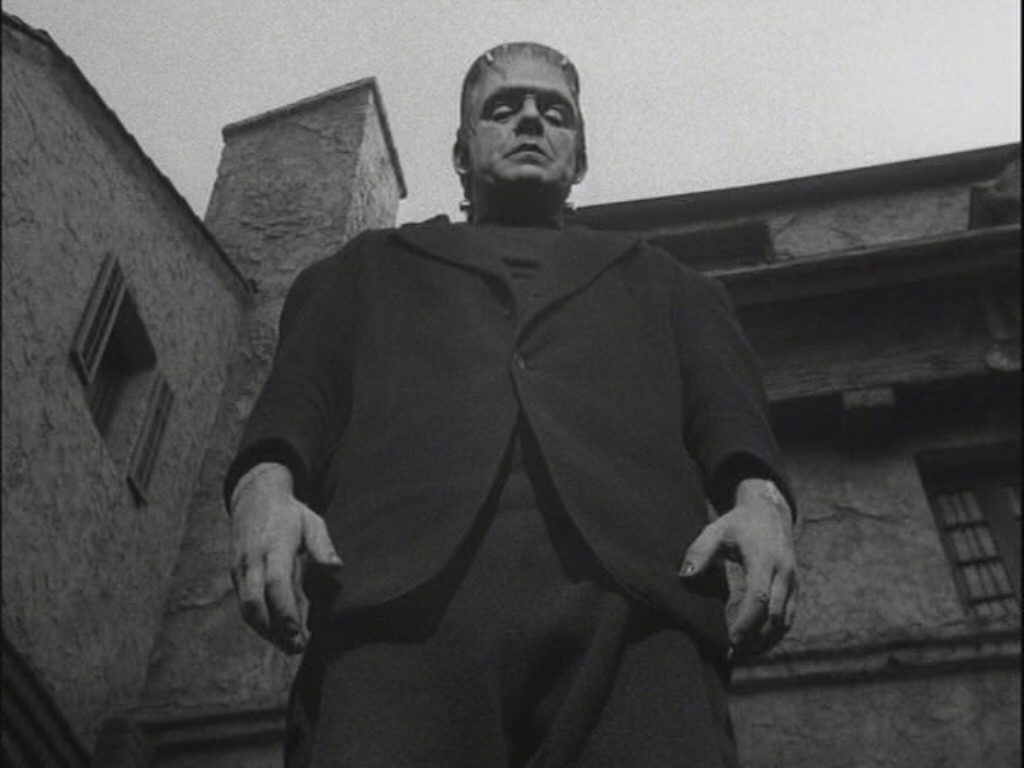
“More Ygor!” undoubtedly went the clamor of Universal Studio’s horror-crazed audience in 1942. Not really, perhaps, but the premise of the final, standalone Frankenstein sequel invites close, perhaps too close, identification with the hunchbacked, broken-necked, and now gut-shot (having apparently survived Wolf von Frankenstein, from the previous installment, emptying a revolver’s-worth of bullets into him) sole “friend” and only protector to the Monster.
The “Ghost” of the title refers, I believe, to a phantasmal appearance of the long-dead father to the remaining male scion of the clearly-cursed Frankenstein dynasty, Ludwig, but one imagines the actual reference could be just as murky and malleable as in the three previous, corpse-cobbling installments. In the musical chairs-like casting practices of Universal’s horror department, the Wolf Man trades in his hirsute hair suit for the chalkier blue-green layers of grease paint; suggesting some of the pathos of the creature behind the still-impressive makeup, but little of the menace. (Indeed, the loss of the actor originally billed as “?” serves, unfortunately, to literalize his now “ghost”-like impact in all subsequent Monster terrorizings.)
By this point in the series, the dubious screenplay device from the original Frankenstein of Ygor’s hunchbacked predecessor – the Monster’s first murder victim, Fritz – having accidentally secured an “abnormal” brain, thus explaining the creature’s unstable behavior, becomes the ever more dubious plot fulcrum upon which this and all further Universal Frankenstein appearances will turn. And here there are two significant problems this causes in our latter Ghost episode of the Frankenstein saga:
The first has to do with the Monster himself. Building on an episode from the original Frankenstein in which he accidentally drowns a little girl, the Monster so strongly identifies with another little girl here that he kidnaps and attempts to force the latest Frankenstein scientist to replace his own brain with the child’s. Ridiculous as it sounds, it is also, from a latterday perspective, as creepy as it sounds; evincing, undoubtedly unintentionally, an almost pedophiliac impulse from the Monster that becomes horror of an entirely different and tonally inconsistent kind.
The second has to do with poor, malevolent, murderous Ygor. The desire to, in essence, “trade in” his own broken body for that of the seemingly immortal and omnipotent Monster’s is clear enough; however, the rigorous philosophical, spiritual, and indeed metaphysical implications of mind-body transfer seem more than a bit beyond the storytelling demands of a B-movie production and, instead, we the audience are left to giggle at the “v”-accented syllables pouring forth like some demented cartoon parody of Adolph Hitler from a “seven-and-a-half foot long, fifty-four inch wide… GORILLA?!”
Possibly the unknowingly self-parodying aspect of The Ghost of Frankenstein is part of the fun, but it does seem a bit of a letdown to witness the monster robbed of his power to truly terrify.
Frankenstein Meets the Wolf Man/House of Frankenstein/House of Dracula
(1943, dir. Roy William Neill/1944, dir. Erle C. Kenton/1945, dir. Erle C. Kenton)
Appropriate to having been effectively rendered a literal and metaphorical “ghost” in his final, standalone feature, the Monster provides reliably menacing if faintly dull “presence” in Universal’s subsequent screen usages. As such, no longer to fully carry an audience’s interest or sympathy, the Monster is subsequently paired with all manner of compensating screen monstrosity, the diminishing returns in over-familiarity breeding if not the contempt of its still-enthusiastic audience, then more likely its yawning indifference. But the monster mash-ups made between 1943 and 1945 are undeniably fun, and even if one can’t quite recall whether he plunged into a sulphur pit or burned in a laboratory or blew up in a mansion when watching whatever mad scientist newly attempting to “tame” the Monster’s destructive capabilities (ah, folly!), there is a certain ritualistic fascination in witnessing the same mistakes being made over and over again, and then over and over again some more.
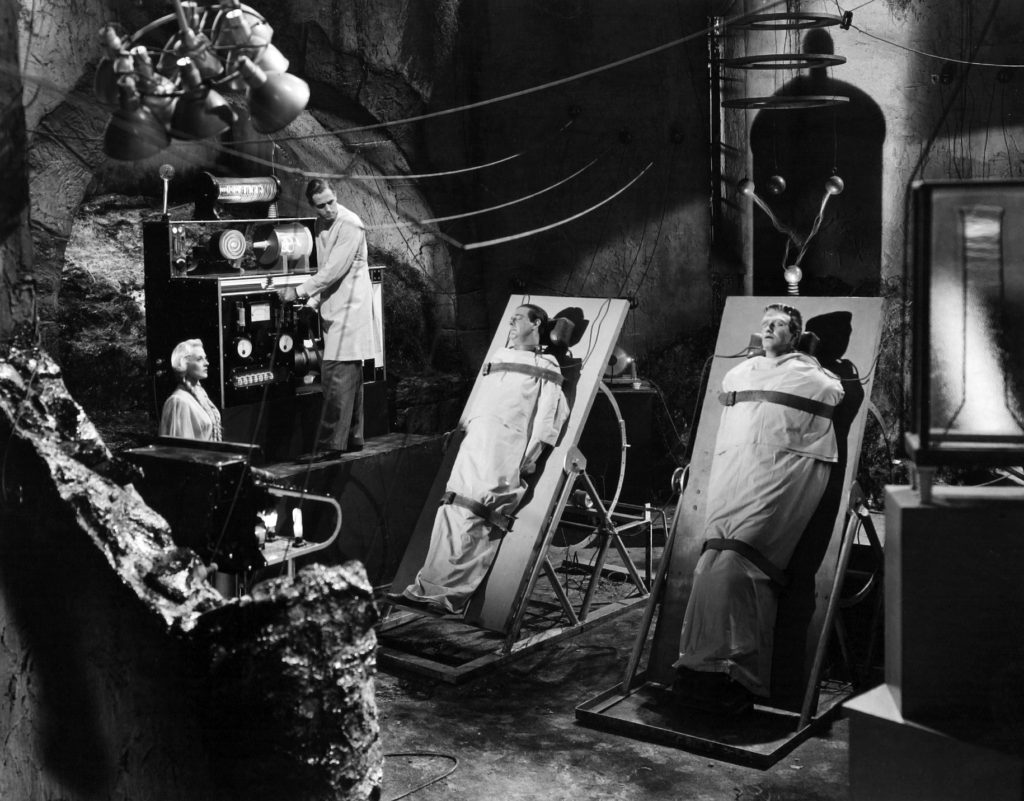
Though he gets top billing, the Monster in his first team-up appears opposite the more prominent and dramatically interesting Wolf Man, who, having portrayed the Monster in The Ghost of Frankenstein, here re-dons his hairy suit and whiskers, ceding in both characterization and makeup a significantly streamlined creature of science to the screen figure who previously provided the creature’s brain. (Even Universal at this point, however, proved reluctant to gift the Monster with Dracula‘s voice again; the Monster remains mercifully mute.) Frankenstein actually Meets the Wolfman only about halfway through, and then only provides inescapable temptation to the obligatory scientific/medical practitioner attempting to also “cure” the much maligned Wolf Man (through brain transfer, yet again!), but the gruesome pair screen effectively engage in a full-on monster fight which results in the spectacular destruction of a small village.
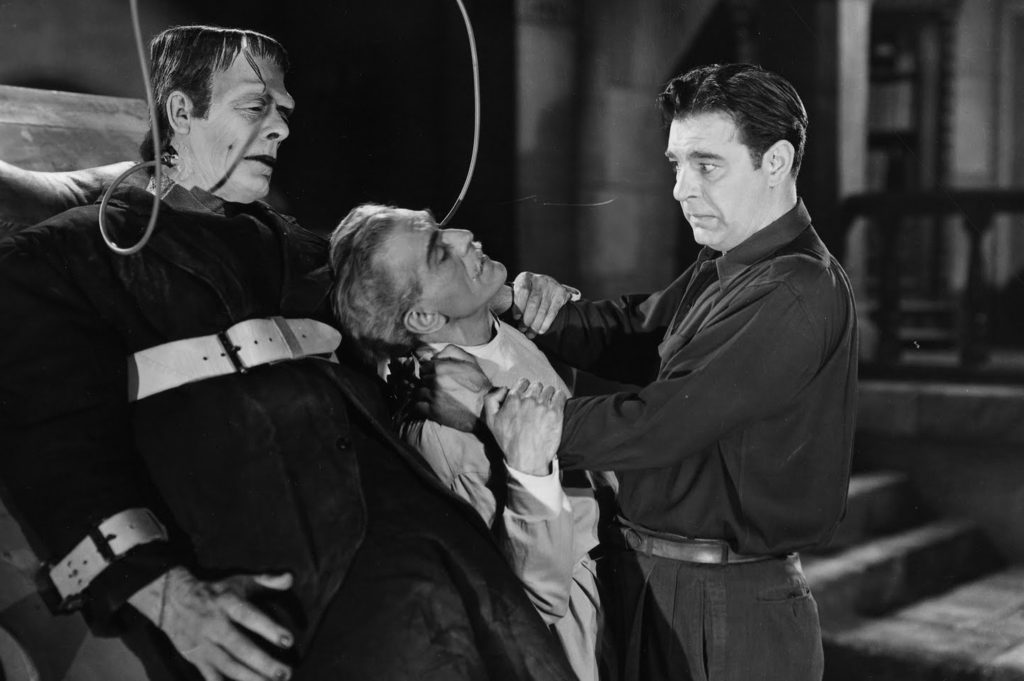
“More” becomes infinitely “less” as clearly beleaguered Universal screenwriters attempt to shoehorn in Dracula and the Wolf Man, along with Frankenstein’s Monster – with uncredited assists from The Hunchback of Notre Dame and Dr. Jekyll and Mr. Hyde – in the cyclically terminating House of Frankenstein/Dracula sequels-to-all-sequels. Appearing as little more than a walk-on in both films, there is still undeniable power in House of Frankenstein when the Monster sinks in quicksand with a Mad Scientist, played by none other than the uncanny actor who originated the former role, and provides a merciful end to House of Dracula by destroying the equipment, experiments, and castle of yet another overambtious Ph.D.
All-powerful and unstoppable, the Monster had also become less relatably human and more machine-like to the point where he is portrayed in these two final appearances by a stuntman who apparently specialized in screen robots. Though I wouldn’t want to take the analogy too far, it is tempting to think of these final Frankenstein appearances in terms of their release dates – December of both 1944 and 1945 – and the real-life destructive forces that would soon be unleashed by actual overreaching scientists during that same period. Infinitely more terrifying than any fantasy, the fictional representation of transgressive advances in the creation of energy and power does have significant symbolic ramifications when those same creative impulses result, rather, in pure destruction. Once again, the true power of horror!
Abbott and Costello Meet Frankenstein/Young Frankenstein/Frankenweenie
(1948, dir. Charles Barton/1974, Twentieth Century-Fox, dir. Mel Brooks/1984, Disney, dir. Tim Burton)
Having been sufficiently shorn of any truly terrifying screen qualities through, to date, seven screen appearances, and having appeared unintentionally funny in at least three of them, it probably seemed appropriate to the top brass at Universal to pair their long-moldering horror properties (none had appeared on-screen since 1945’s House of Dracula) with their top contract comedians, Bud Abbott and Lou Costello, for actual and intentional screen comedy. And thus the horror movie parody was born!
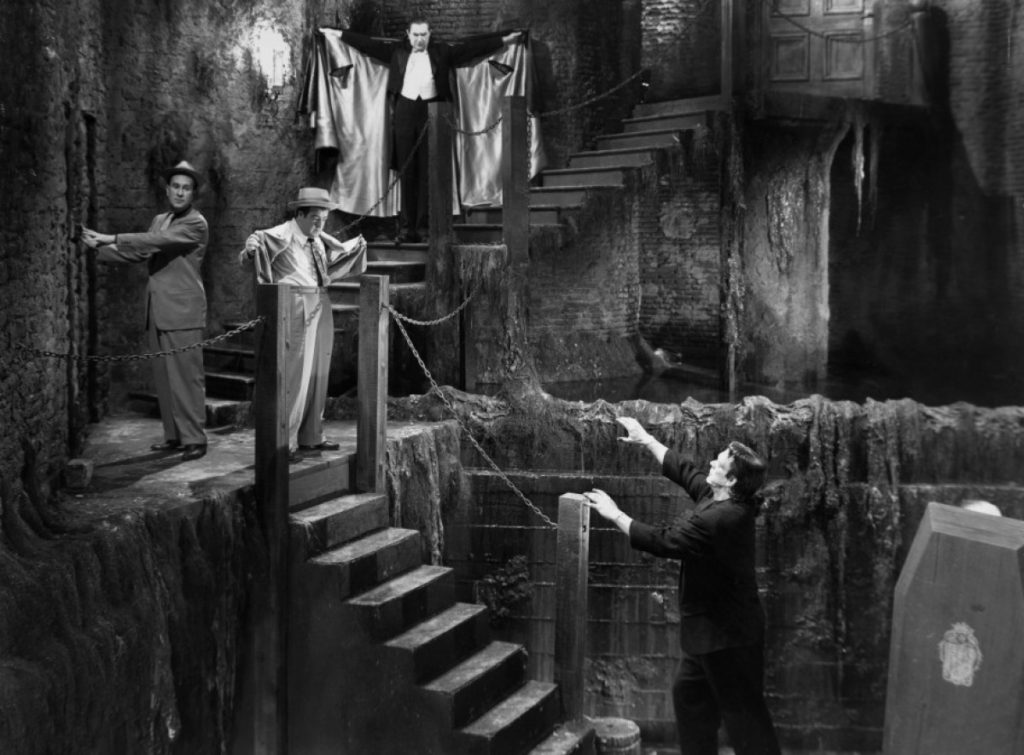
Already having demonstrated his breathlessly stammering and cowardly gasping screen prowess in multiple features (most notably 1941’s Hold That Ghost), Lou Costello was virtually made-to-order to react in similar scaredy cat fashion to, in succession, the Wolf Man, Dracula, and Frankenstein’s Monster. Though overshadowed on-screen by the iconic horror actors’ return to their immortal roles, the Monster is nonetheless credited in the film’s title, Abbott and Costello Meet Frankenstein, and dutifully lumbers about as fearsome foil to Lou’s over-antic antics with enough effect to ensure that Bud & Lou would later Meet the Invisible Man (1951), Dr. Jekyll and Mr. Hyde (1953), and even The Killer himself, Boris Karloff (1949), in subsequent screen outings. One can only wonder, though, how the unbeatable comedy dynamic between Bud & Lou might have been affected had the plot of Dracula and his femme fatale co-conspirator, the enticing Dr. Sandra Mornay, succeeded and the Monster’s brain been replaced with that of… Lou Costello’s. (Certainly, at the very least, Monster Lou would be taking far less crap off Bud.)
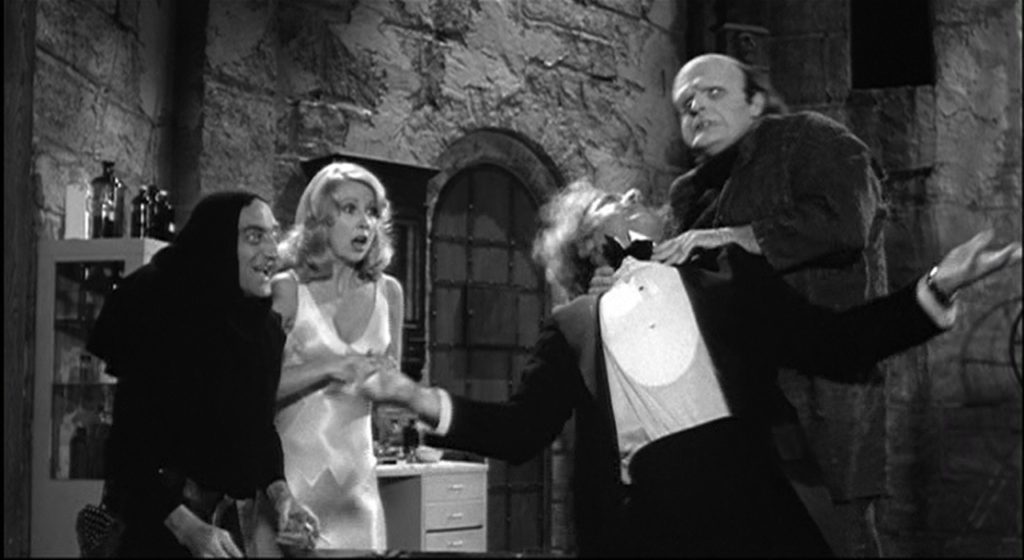
It took nearly 25 years, but the horror movie parody genre received another electrifying jolt! courtesy of Young Frankenstein. As one of my top favorite movies ever, I have written about it before, and even before that, so possibly I have less to say about that most difficult to write about genre of film, the screen comedy – and the even more difficult to write about sub-genre of film, the parody (and possibly the even even more difficult to write about sub-sub-genre of film, the genre parody) – but as I am helpfully writing here about only one aspect of the movie, the representation of the Monster, I can say, equally helpfully, that this most affectionate of screen parodies is not only minutely aware of each visual, thematic, and plot point related to every previous appearance of Universal’s Frankenstein Monster, but actually expands and heightens this most monstrous of all screen images to sublime comic effect. (Quite literally.) As that 137-word sentence might attest, I could go on and on, cataloging each and every scene and how it precisely matches and then comically transcends its original, but instead I’ll leave it at the word Blücher! and let a team of wildly neighing horses take care of the rest.
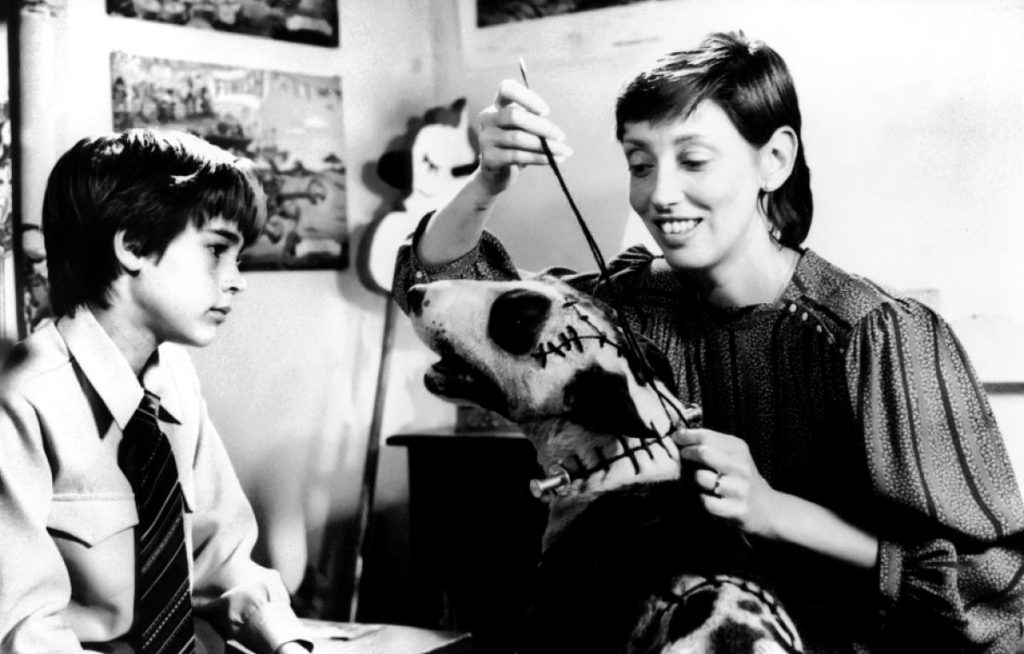
Young Frankenstein is also one of the few (and possibly only?) tale(s) of mad science gone awry, even of parody, where the Mad Scientist figure personally sacrifices an aspect of himself – in young Froodrik Fronkensteen’s case, part of his brain – in order to becalm and pacify his ungodly creation. That altruistic aspect of mad science is also present in 1984’s fiendishly clever black-and-white children’s short, Frankenweenie. Modern-day child of the suburbs Victor Frankenstein, reclaiming the “victorious” name of life over death from the original novel (which still looks funny on a mailbox), revives his dear deceased dog using the fictionally-proven (though scientifically-unsound) method of electrocution/galvanization, the “divine spark” of which is also derived from the original novel (and as demonstrated in a third grade science lab experiment on an “ex-frog”). A without punning dead-on recreation of the original 1931 Frankenstein, Frankenweenie – re-made as a delightful full-length animated feature in 2013 – comes fully equipped with an Expressionistic pet cemetery of stark hills and animal-shaped tombstones, an upstairs bedroom laboratory of garage-itemed electrical knick-knacks (including a buzzing waffle iron and perpetual motion Christmas reindeer display), a burning windmill model in a miniature golf course, and a lovable stitch-laden mutt at the heart of it all. A horror parody for the whole family!
Spirit of the Beehive/Gods and Monsters
(1973, Spain, dir. Victor Erice/1998, Showtime/Regent/BBC Films, dir. Bill Condon)
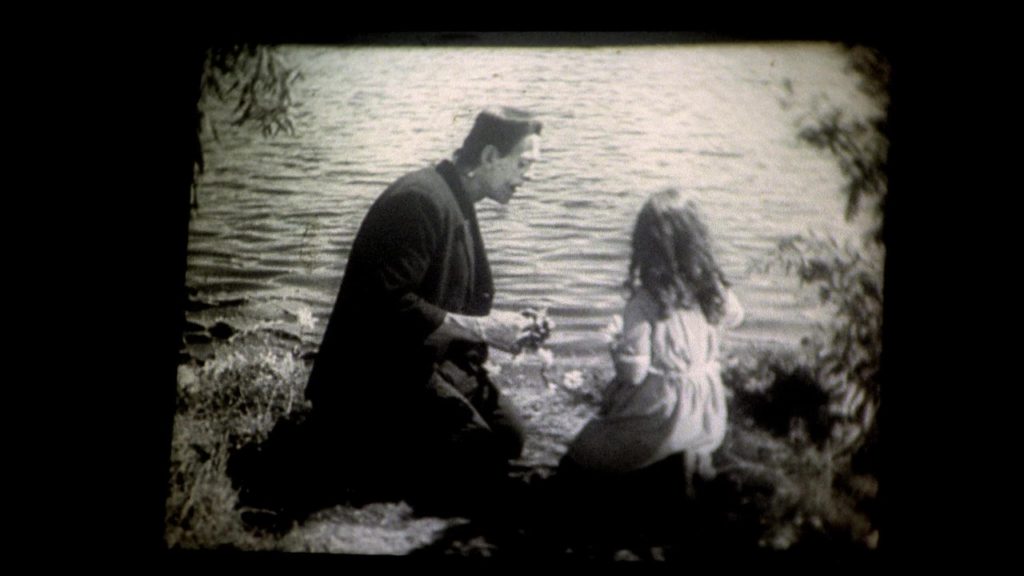
If a fictional character has any resonance beyond the page or screen, Frankenstein’s Monster has undoubtedly rampaged through the waking dreams and nightmares of children the world over since his most powerful and screen iconic appearance in the 1931 Frankenstein. Set in a small, remote Castilian village in 1940, at the outset of Franco’s 30-year, fascist rule of Spain, a six-year-old girl sees the original Frankenstein for the first time in a makeshift local exhibition of the movie classic. Showing her reactions as she watches the action unfold on-screen, the girl is clearly entranced by what she is witnessing; which it also becomes clear that she is interpreting, despite her older sister’s warnings to the contrary, not merely as a story but as reality.
Character and setting become inextricably bound between the world of story and the world of movies as the little girl merges the roving hills and deep forests of her hometown with the images of a misbegotten monster roaming the stark countryside. A well by a lonely hut on the plains, for instance, becomes the place where “his” spirit resides, and, at one point, the arrival of a fleeing, wounded Republican soldier/outlaw becomes as clear a forlorn figure as the Monster on the screen… Even later, however, as she herself flees the apparent misunderstanding of her family, a scene set by a pond in the moonlight recreates a scene from the movie that affected her most: where the Monster killed the small child. And, sure enough, as she waits by the pond, the Monster then appears!
Without revealing more, I could say that that “encounter” just about demonstrates everything that is both wonderful and scary about movies as an art form. A “monster”, however frightening, is simply a metaphor for an unnamed terror (here, conveniently given the name “Frankenstein”), but for reality and fiction to merge in such undelineated terms – at that early period of life, no less – must give both a power that neither has on their own.
Indeed, as a person interested in film history and theory, I as a viewer further wonder/worry about which version of the 1931 Frankenstein the child has actually viewed. Ambiguous, perhaps, from the elided manner the film is presented (and possibly intentionally so), did Ana see the full, uncut version that shows the Monster accidentally killing the child, OR the more readily available, post 1934-distributed version that implies, through the monstrosity (pun intended) of Hollywood’s Production Code, that the Monster willfully and savagely murdered the child?
In any event, that such a scene, with its multiple and evocative layers, should have such an effect on even a hardened film fan as I fancy myself to be, shows, I hope, the unique and bewitching effect that is an equal testament to the “legacy” of the film it comments on and reacts to. In purely poetic terms, Spirit of the Beehive is on a short-list of movies that accurately reflects the perceptive force of children and their intensely personal relationship to what they see on the big screen. (Something, I feel, that film fans and film critics alike too easily forget.)
…
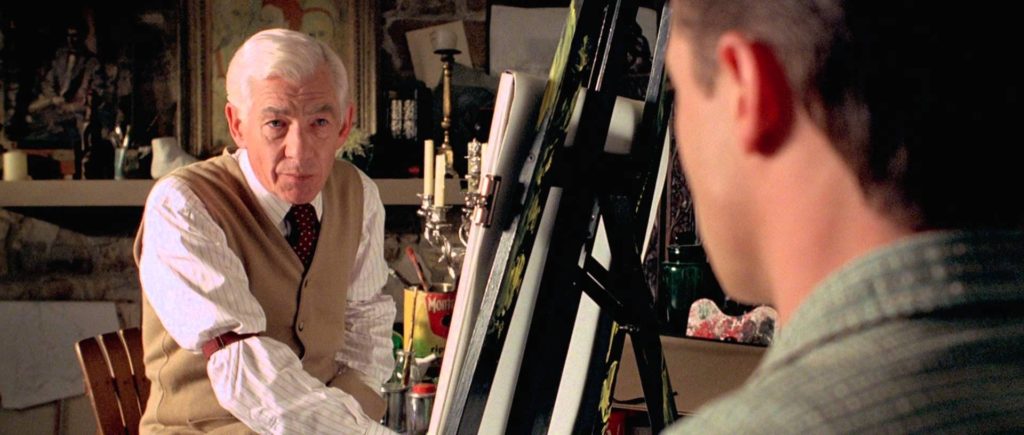
Our final selection wraps around to the creative force behind the original 1931 screen Frankenstein in an accomplished late-1990s independent feature that documents the final days of the Monster’s true screen creator, James Whale. Set in 1957, the gay, elderly film director – who has not made a feature in 16 years, and is by now a largely-forgotten Hollywood figure – has suffered a series of strokes that has left him mentally, if not physically, paralyzed. Haunted by memories of the past, and by mental images he can no longer control, the visionary filmmaker becomes fixated on his modest home’s gentle though rough-hewn gardener, whose flattened, angular, and seemingly “architectural” skull-shape inevitably appeals directly to the visual stylist’s aesthetic sensibilities…
Taken from a toast given “To a new world of gods and monsters!” by Dr. Pretorius (over a dead young woman’s coffin, as I recall) in Bride of Frankenstein, Gods and Monsters reflects on the legacy of Whale’s first two Frankenstein movies in relation to both the famed director’s biographical details and his inspiration for the Monster. Through his neurological distress, the viewer is presented with episodes from Whale’s impoverished working class English background, his traumatic experiences as a British officer in the foul trenches of World War I (“The Great War”), and his moment of artistic triumph when he realized a vision of dread on the screen with unmatched style, wit, and a certain panache.
Though casual viewers may be unfamiliar with Whale, everyone is undoubtedly familiar with his Monster, and it is that image which continues to loom large over popular art, culture, and history. In adapting a dense and philosophical 19th century Gothic horror novel to the big screen, the 1931 Frankenstein drew the essentially outcast, socially rejected figure from its source material and rendered it as universal a screen figure as the aegis of the movie studio under which the initial film was produced. A strongly and deeply felt screen presentation of possibly the most effectively primal movie character ever filmed, the depth of humanity in its stitched-together, death-reanimated simulacrum is as terrifying as it is beautiful, and it is largely Whale’s vision that gave it that power.
By now, one might realize that I have gotten through about 4,000 words and now 12 movies without once mentioning, discussing, or even name-dropping a single screen credit… until now. In one of Gods and Monster‘s most haunting images, the director is led by his gardener friend – appearing finally in the work clothes, heavy boots, and makeup of the Monster – through his own life-ending psyche, across a stark battleground, to be laid next to his first lover, 40-years-dead in a heaping corpse-strewn battle trench. Though one might hesitate to assign ownership in a collaborative medium like film, a movie and Frankenstein fan can’t help but feel, if for nothing other than the evidence of this persuasive and unusual screen biography, that the Movie Monster is unambiguously a James Whale creation. Born from death, stitched together from corpses, reanimated by forces beyond human comprehension, the Monster finally appears as an angel of death, a forlorn figure of terror one might further hesitate to call “Friend?”, but whose power 85 years of film history certainly cannot deny.


